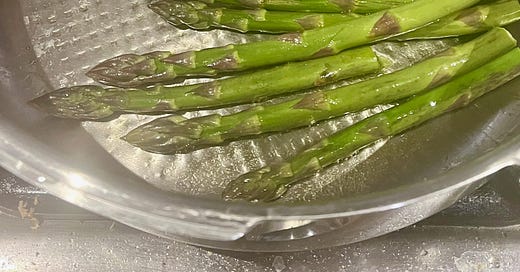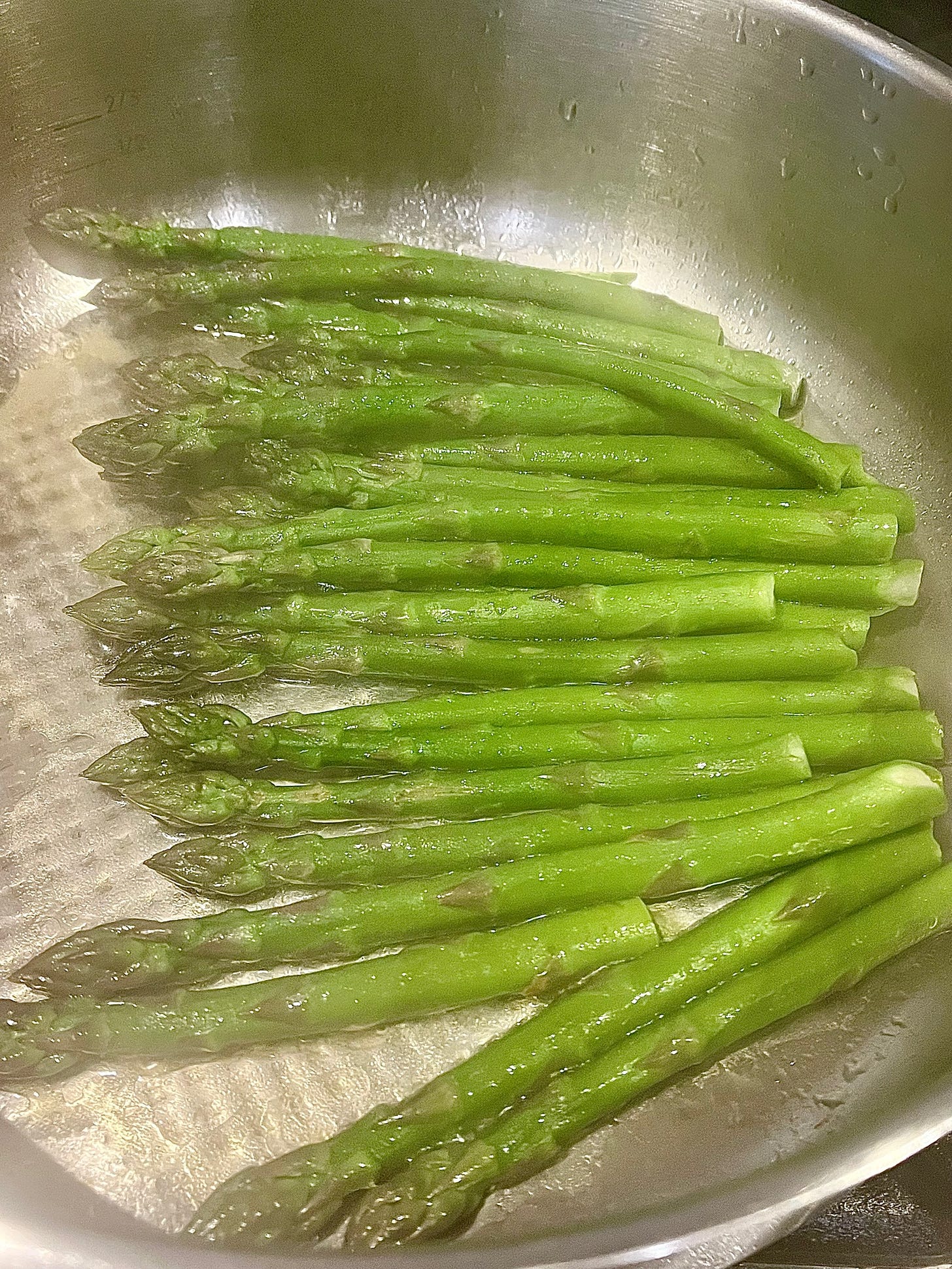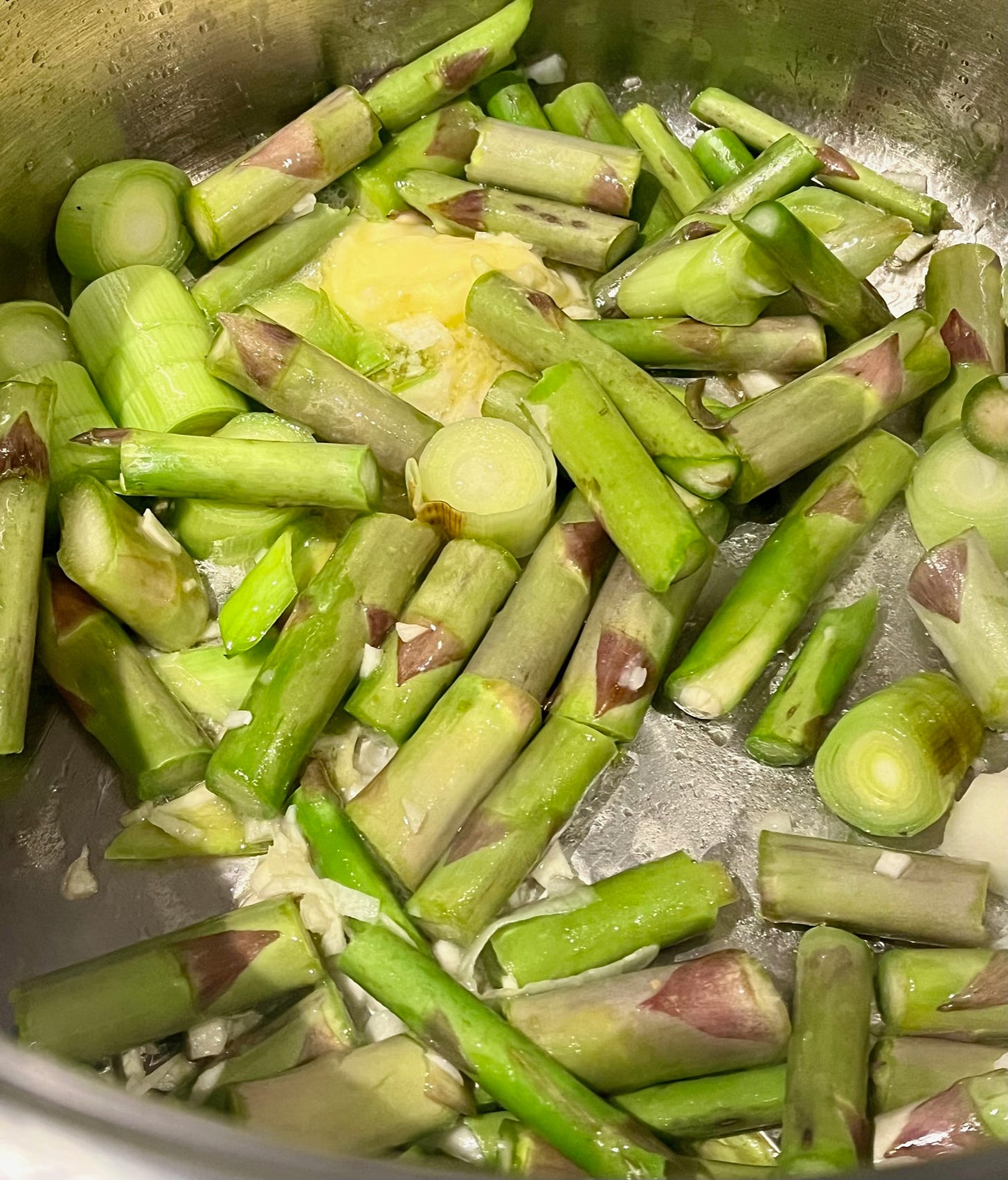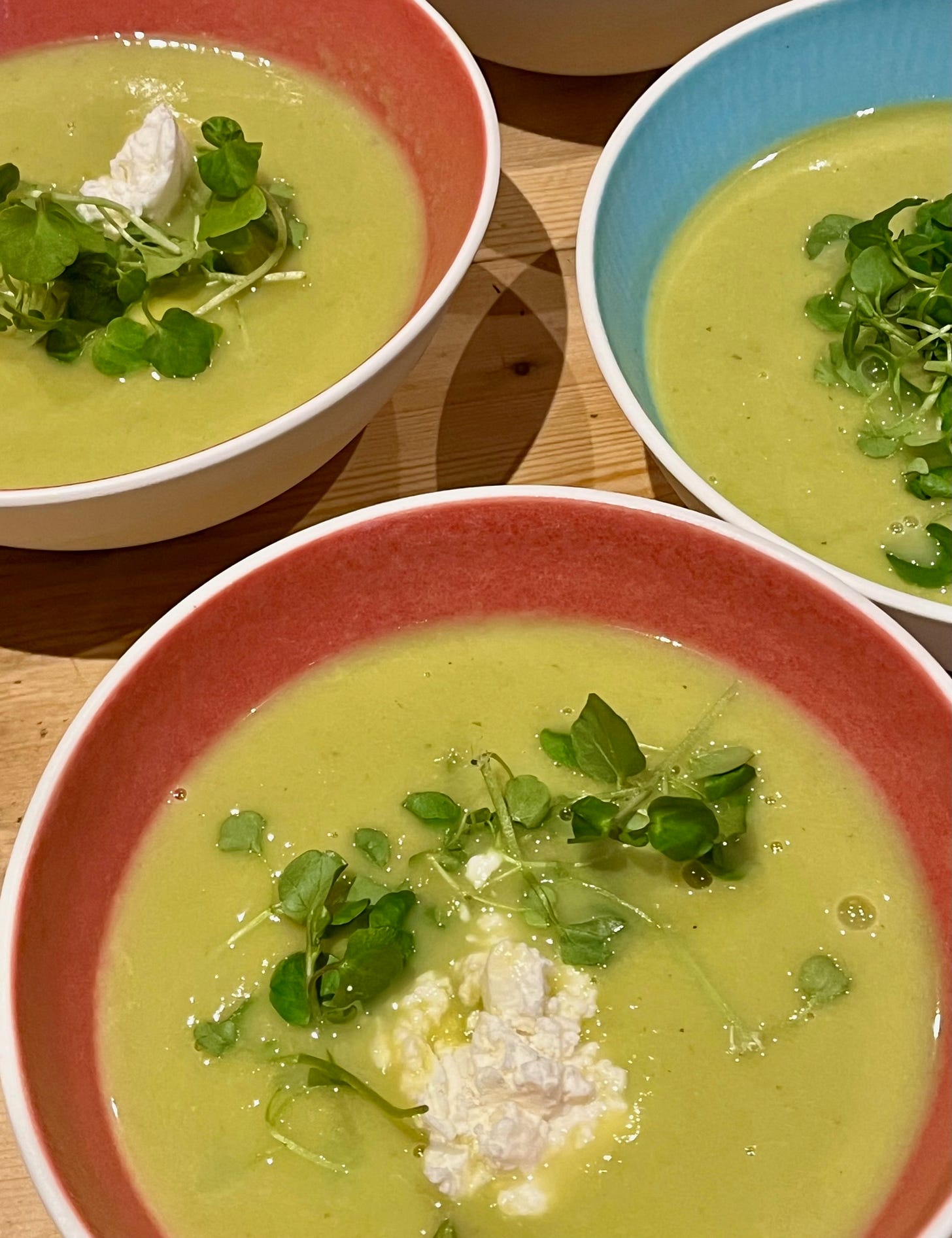One of my aims with this newsletter is to be as seasonal as possible with my recipes. I am not intending on giving you a farmers market report every week, as tempting as that is (my friend Deborah Robertson does this brilliantly in her newsletter Lickedspoon), but I will be sharing recipes with my own spoils because when I am not all out recipe developing/testing for a project, that is how I prefer to shop and eat. Whichever season I am in, it is my favourite in that moment. Asparagus is preceded by purple sprouting broccoli, which in some ways I enjoy more as it is such a gap bridger between winter and spring – and when I am organised enough to grow it, I love how my plants can be decimated by caterpillars by the end of summer, but have fully recovered enough to give me an abundant and long lasting crop by the following March. And now I think about it, much of what I am saying about asparagus, including how to prepare and cook, applies to PSB too.
Usually with the asparagus season I make myself to wait a couple of weeks as the price is initially ridiculous. And even then I will shop around because in some places the price can remain ridiculous. Early bunches, often meanly split (I have seen as few as 6-8 slender stems in a bunch), can fetch a tenner in some high priced grocers, when down the road, the less fashionable, every day greengrocer has generous bunches for £2.50. At the farmer’s market I am paying £6 for 2 bunches. There is, as far as I can tell, no difference in quality – the asparagus is all British – mine currently comes from the south coast near Hastings, the Wye Valley on the Welsh boarder, the Vale of Evesham in Worcestershire, but every rural area will currently have farm shops bursting with the stuff. When I lived in Norfolk I used to regularly go on magical mystery tours, following trails of makeshift plywood signs all over the place and would gorge on pickings from the farm gate honesty boxes.
Asparagus requires little cooking so not an obvious candidate for pressure cooking, but I am on a mission to show that even the most delicate greens can be cooked to a bright green al dente in the pressure cooker. It is this kind of cooking which ensures your pressure cooker is used on a daily basis. I do have to qualify this – it can be dependent on your pressure cooker coming up to pressure fast. There are ways to help this along, but I do understand that some of the electric pressure cookers can be a little stubborn in this regard. If you have an electric pressure cooker and find that it can be slow coming up to pressure, you do have to adjust the way you cook things. I will write about this in much more depth at some stage, but with something like asparagus, steaming above water instead of leaving it on the base can make all the difference. Regardless, you will be fine with today’s soup recipe which I will eventually get to.
But first, how to quickly roast or steam asparagus in the pressure cooker? The most important thing here is preheating and searing. To roast asparagus, heat your pressure cooker up then add a tablespoon or two of olive oil. Heat for another minute, then add washed asparagus. Let the asparagus sear very briefly on all sides and sprinkle over plenty of salt. You should be seeing plenty of steam by this point and if I am using my shallow, saute style pressure cooker, I would probably not bother adding any extra water, but for anything with a larger capacity than 3l, you will need to add water. 50ml can be enough for up to 4.5-5 litres, for anything larger, 100ml should be ample. The trick is at this point is to work fast. Throw in the water – it will generate a lot of steam as soon as it hits the base of the cooker – then as fast as you can, fix the lid into place. You should find that your pressure cooker will immediately start coming up to pressure. When I do this in my saute pan, it is almost instant – the pressure rises to full pressure in less than 30 seconds. For a larger cooker, it can take up to a minute.
How long you cook it for at this point depends on your cooker and exactly how you like your asparagus. If I am using the saute pressure cooker, I will leave it for 30 seconds-1 minute for the crunchy side of al dente to al dente. Any more and it will be soft. In a larger pressure cooker, I will do zero minutes to 30 seconds. But this is something that is very individual and you will have to do a little trial and error here. Then it is important to fast release - the difference between al dente asparagus and mushy asparagus can be as little as a 30 second delay in getting that lid open.
You can “steam” the asparagus in a similar way – in this case I will use exactly the same timings as above, but instead of adding oil to the base of the cooker, I will add water, wait for it to get really hot and start giving off a lot of steam, then add the asparagus. This is all good for asparagus in a single layer – if I am doing a larger amount, I will use a steamer basket instead. The timings for this are again dependent on how long your cooker takes to come up to pressure. So for a recalcitrant electric pressure cooker I would do zero-1 minute, for a fast working stove top, I would do 1-2 minutes.
Now onto the recipe proper. One of the (many) reasons I love pressure cooking is the sustainable element of it. We are all trying to be more sustainable – I am forever working leftovers into meals and trying to use every scrap of vegetables in things. But I am not going to do this if the cooking method isn’t energy efficient. I see very little point in roasting some potato peelings or cauliflower stems if the oven isn’t already on for something else.
This recipe uses asparagus trimmings. We are all taught that best way to avoid any woodiness in asparagus is to bend each stalk and it will naturally snap at the point between tender and fibrous. I have my doubts about this as I often see it should have been further down the stem (this might be down to my technique), but I do still usually do it as often on automatic pilot when it comes to kitchen prep. Even if I trim with a knife instead, there are still woody ends to discard.
I will save these to add to light, summery stocks – put them in the freezer and wait until I have pea pods. Add a few aromatics and you can have a lively green stock ready in no time at all – I simply bring up to high pressure, cook for 1 minute and leave to drop pressure naturally. You can make a wonderful risotto with this stock, garnished with asparagus roasted in the way I describe above.
But this weekend it occurred to me that there is so much flavour in those stems I could skip the stock bit and go straight onto soup. So that’s what I did.
Pea and Asparagus Trimmings Soup
15g butter
1 leek, shredded (include the green bits)
200g asparagus trimmings
1 floury potato, peeled and diced (optional)
2 cloves garlic, sliced
250g peas (frozen are fine)
Leaves from a large sprig of tarragon
1 piece lime zest
Melt the butter in your pressure cooker and add the leek, asparagus trimmings and potato. Stir until everything is glossy with butter, then add the garlic and cook for a further couple of minutes. Add the peas, tarragon and lime zest, then season with plenty of salt and pepper as well if you like. Pour over 600ml water (you can use stock if you prefer, but I like the clean flavour from water in this one).
Close the lid and bring up to high pressure. Cook for 2 minutes at high pressure and FPR. Remove the lime zest from the cooker then blitz until smooth, using an immersion blender or by transferring to a jug blender. If your blender is powerful, it should make short work of the softened asparagus stems, but you can push through a sieve if you want to make completely sure (I didn’t bother – my old Braun immersion blender did the job).
Taste for seasoning and add a judicious squeeze of lime juice to bring all the flavours together. I find it doesn’t need milk and cream - blending soups to smooth incorporates air which gives a rich, creaminess of its own. Plus there is already butter. But by all means, add whatever you like.
I served this ladled over poached eggs, with a handful of watercress microleaves (also from the farmers market - I buy huge bags of various microleaves/mixes at £3.50 a pop - immensely good value and they last up to 2 weeks if they don’t get eaten) and some goat’s curd. These are very much suggestions, add what you like. And I should also say that this is an excellent soup for using up any salad greens you have lying around too – the sort that are just past their prime so a bit wilted – fine to cook with but unredeemable in terms of crisp.








Btw, today‘s (27.5.23) Ottolenghi steaming recipes from the Guardian are perfect for pressure cooking. Rather than steaming eggplant for 20 min in a conventional pot, I have steamed it for
First, I completely agree with you on oven use. All those oven risotto recipes drive me bonkers!
Second, what is the diameter (and make) of your pressure frying pan? Asking because my pressure cookers are all 22 cm, which means I have to steam my (white) asparagus standing up in my 6-liter pot - otherwise I‘d have to cut the ends off, and that would be a pity. So is your pan wider than 22 cm?
Lastly, re your recipe: you don’t peel the ends of your green asparagus? I don‘t cook it very often (prefer white) but the ends of the ones I have cooked with have been quite woody - I don‘t think even pressure cooking would have softened them enough without peeling.